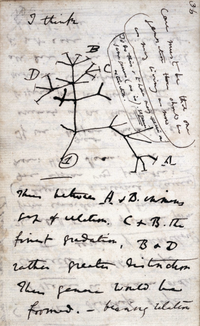
Photo from wikipedia
Correlational selection is defined as selection for adaptive character combinations, and it therefore favours combinations of coevolved traits via phenotypic integration. Whereas the evolution of avian nest-building and egg-laying characteristics… Click to show full abstract
Correlational selection is defined as selection for adaptive character combinations, and it therefore favours combinations of coevolved traits via phenotypic integration. Whereas the evolution of avian nest-building and egg-laying characteristics are well understood, their correlated dynamics remain overlooked. Here, we examined patterns of correlated evolution between nest, egg and clutch characteristics in 855 species of birds from 90 families, representing nearly 9% and 33% of avian species- and family-level diversity. We show that the ancestral state of birds’ nests was semi-open with nest sites having since become progressively more open over time. Furthermore, nest characteristics appear to have influenced egg-laying patterns in that while semi-open nests with variable clutch sizes were probably ancestral, clutch sizes have declined over evolutionary time in both open and closed nests. Ancestrally, avian eggs were also large, heavy and either elliptic or round, and there have been high transition rates from elliptic to round eggs in open nests and vice versa in closed nests. Ancestrally, both unpigmented (white) and pigmented (blue–brown) eggs were laid in open nests, although blue–brown eggs have transitioned more to white over time in open and closed nests, independently. We conclude that there has been a remarkable level of correlated evolution between the nest and egg characteristics of birds, which supports scenarios of correlational selection on both of these extended avian phenotypes.
Journal Title: Animal Behaviour
Year Published: 2019
Link to full text (if available)
Share on Social Media: Sign Up to like & get
recommendations!